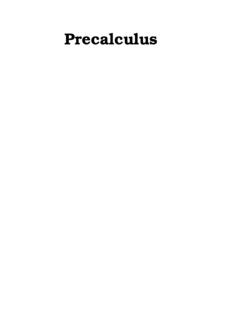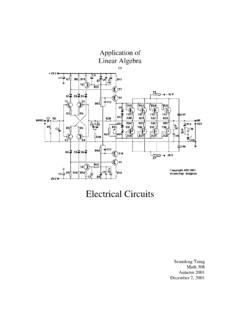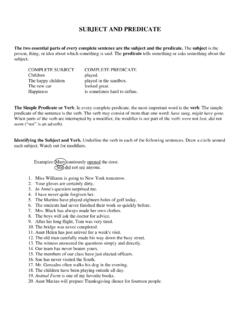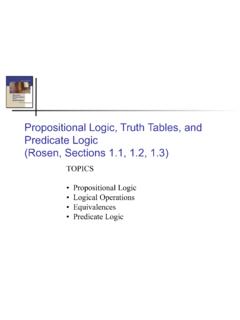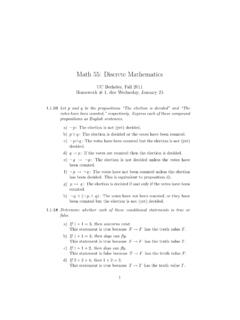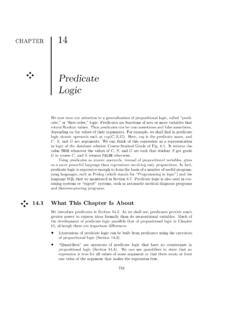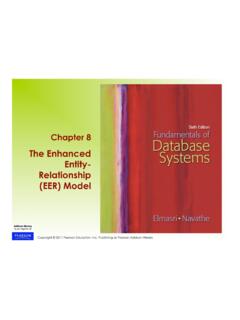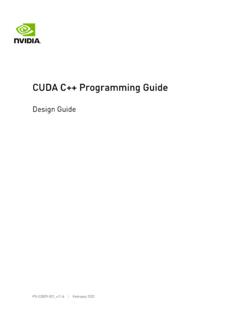Transcription of Quantifiers and Negation for all
1 Quantifiers and NegationFor all of you, there exists information about quantifiers below. (That was sort of a quantifiers joke, sorry).We often quantify a variable for a statement, or predicate, by claiming a statement holdsfor allvalues of thequantity or we saythere existsa quantity for which the statement holds (at least one). Notationally, we canwrite this in shorthand as follows: x A, P(x),which claims: for allxin the setA, the statementP(x) is true. x A, P(x),which claims: there exists at least onexin the setAsuch that the statementP(x) is are many equivalent way to express these quantifiers inEnglish.
2 Here are a few examples:Universal Quantifier: Here are a few ways to say x N: For all natural numbersx,.. , For allx N,.. , For anyx N,.. , For everyx N,.. Existential Quantifier: Here are a few ways to say x N: There exists a natural numberxsuch that.. , There existsx Nsuch that.. , For at least onex N.. , For somex N.. Nested (or Compound) Quantifiers: It is fairly common to see more than one quantifier in a we see nested quantifiers we must take special care in theorder they appear (as this can effect themeaning).RULE 1: If we are using the same quantifier, then the ordering doesn t For allx Rand for ally R,x+y= 4.
3 , is the same as For ally Rand for allx R,x+y= 4. , which is the same as For allx, y R,x+y= 4. (Note: You should be able to tell that this is a false statement.) There existsx Rand there existy Rsuch thatx+y= 4. , is the same as There existsy Rand there existsx Rsuch thatx+y= 4. , which is the same as There existx, y Rsuch thatx+y= 4. (Note: You should be able to tell that this a true statement.)RULE 2: If we are using mixed quantifiers, then the ordering DOES For allx R, there existsy Rsuch thatx+y= 4. This statement says that the following in this exact order:1. The variablexcan set as ANY real Afterxis set, we can find at AT LEAST ONEybased onxsuch thatx+y= other words, the variableyis nested inside in a sense, so we are saying thatycan be found after wealready selectx.
4 (Note: This is a true statement.) There existsy Rsuch that for allx R,x+y= 4. This statement says that the following in this exact order:1. AT LEAST ONEycan be found BEFORE any other variable is set. And this one specialywill workwithin the rest of the statement no matter what the other variables After this specialyis set, we can put ANYxinto the equationx+y= 4 and it will be other words, the variableyis nested outside in a sense, so we are saying thatycan be found beforehandand it works for allxvalues. (Note: This is a false statement.)Observe: By looking at the two examples above, you should note that x A, y B.
5 And y B, x A, ..are very different quantifications. The second statement is muchstrongerin the sense that if you can findyahead of time, then certainly you can find it after the fact. Thus, if the statement y B, x A, P(x, y) istrue, then automatically the statement x A, y B, P(x, y) must be true (but in general it doesn t go theother way).Aside: Occasionally, you will see a nested quantifier at the end of a statement, in which case it is implied thatthe quantifier is the last in terms of order. For example, hereis the definition of bounded: There existsM Rsuch that|f(x)| Mfor allx R. Note that we wrote a quantifier at the end just to make it sound nice.
6 Putting all quantifiers at the beginning,in the right order, this is the same as There existM Rsuch that for allx R,|f(x)| M. (The order is very important in this definition because you have to find a boundMahead of time that worksfor all values ofx).Important Fact: Quantifiers give the range/universe overwhich the statement is being claimed. When we workwith a quantified statement and start to talk about negationsit is important to remember that the universe does not change (if a statement is quantified for students in this classroom, the Negation will still be quantifiedover students in this classroom).
7 Thus, we are only negatingthe quantifier. Also note that the Negation of thequantifiers is a quick exercise that doesn t require the use of any sophisticated logic rules, you just flip thequantifiers, then negate the statement (when you get to the statement then you will need logic rules to negate). Negation Rules: When we negate a quantified statement, we negate all the quantifiers first, from left to right(keeping the same order), then we negative the [ x A, P(x)] x A, P(x).2. [ x A, P(x)] x A, P(x).3. [ x A, y B, P(x, y)] x A, y B, P(x, y).4. [ x A, y B, P(x, y)] x A, y B, P(x, y).Unrelated, but important, when it comes time to negate the statement remember how to negate an implication: [IFP,THENQ] PAND NOTQ

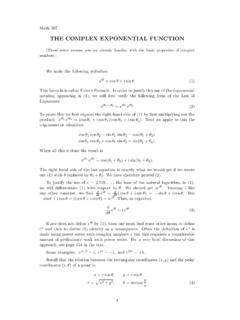

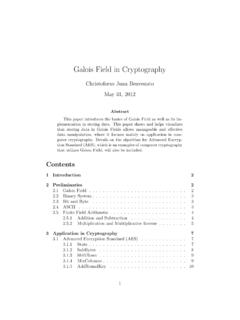

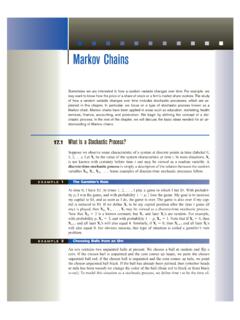
![ZZ dA R [0 2] R - University of Washington](/cache/preview/6/4/c/c/9/f/d/6/thumb-64cc9fd6ac93e2995c04a2a74b217176.jpg)
